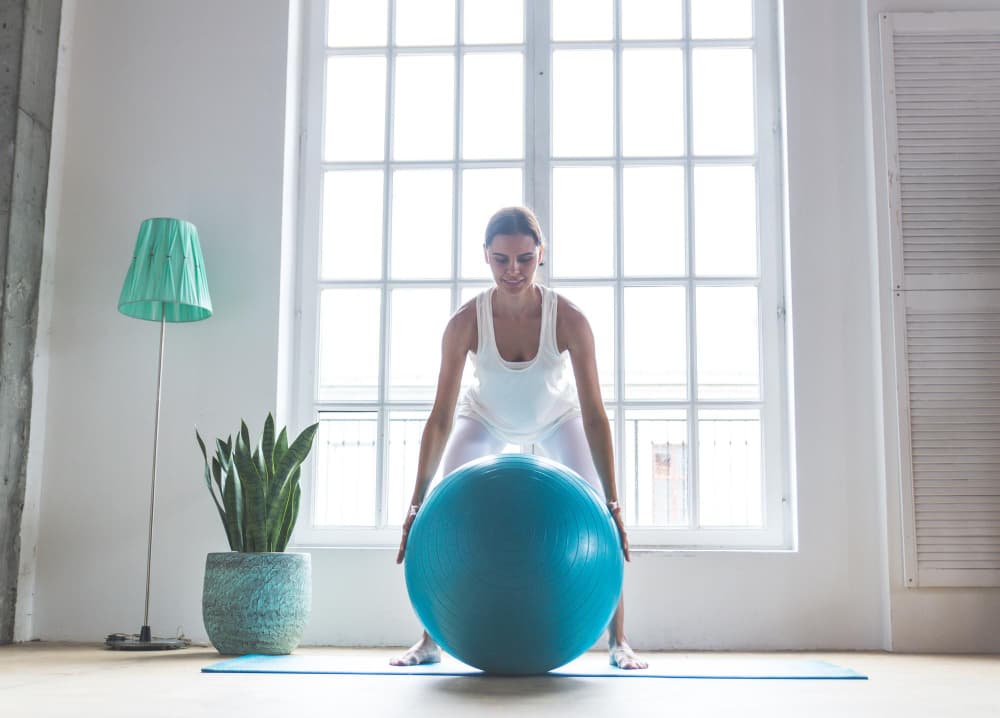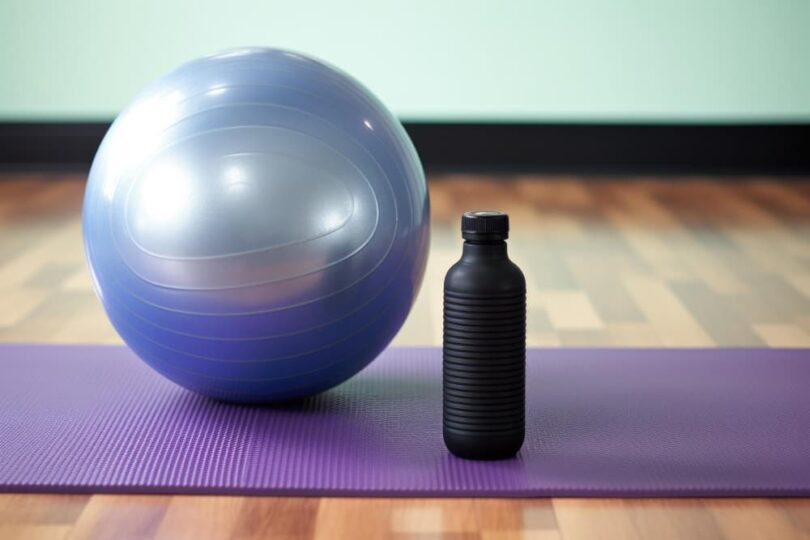Yoga balls, also known as exercise balls or stability balls, have become essential tools in fitness routines worldwide. These versatile tools offer numerous physical and mental benefits, making them a favorite in gyms, homes, and even offices. This article will guide you through the various aspects of yoga balls, including their benefits, types, exercises you can do with them, and tips on choosing the right one.
Table of Contents
What are Yoga Balls?
Yoga balls, sometimes called fitness balls or Swiss balls, are large, inflatable spheres designed to improve balance, strength, and flexibility. Originally developed for physical therapy, they have since become popular in mainstream fitness due to their effectiveness and versatility. Typically made from soft, elastic PVC material, these balls can support significant weight without bursting, making them ideal for various exercises.
History and Origin of Yoga Balls
The concept of the yoga ball dates back to the 1960s when Italian plastic manufacturer Aquilino Cosani first developed it. Initially called the “Pezzi ball,” it was primarily used for physical therapy, especially in neurodevelopmental treatment. Over time, its use expanded into fitness routines, becoming a staple in gyms and home workouts around the globe.
Benefits of Using Yoga Balls
Physical Benefits
Using a yoga ball in your exercise routine can bring many physical benefits. One of the most notable advantages is improved balance and coordination. Since the ball is inherently unstable, it forces your body to engage multiple muscles to stay balanced. This not only strengthens your core but also enhances overall stability.
Moreover, yoga balls are excellent for core muscle strengthening. Exercises like crunches, planks, and bridges performed on a yoga ball require more effort from your abdominal muscles than on a flat surface. This increased engagement leads to a stronger and more toned core over time.
In addition, these balls can help improve flexibility. Regular use of a yoga ball encourages stretching and lengthening of muscles, which can help prevent injuries and improve range of motion.
Mental and Emotional Benefits
Beyond the physical perks, yoga balls also offer mental and emotional benefits. Working out with a yoga ball can be a great stress reliever. The gentle, rhythmic movements and focus required to maintain balance can help reduce anxiety and promote relaxation. This can particularly benefit those looking to combine physical exercise with mindfulness practices.
Furthermore, using a yoga ball can improve focus and concentration. The need to constantly adjust and balance engages your mind, making it a fantastic tool for mental sharpness and cognitive function.
Types of Yoga Balls
Standard Yoga Balls
Standard yoga balls are the most common type. They are versatile and can be used for various exercises, from simple stretches to more complex strength training routines. Typically available in different sizes, these balls are great for both beginners and advanced users.
Anti-Burst Yoga Balls
Anti-burst yoga balls are designed to prevent sudden deflation in case of a puncture. They are made from a thicker material that ensures slow deflation, providing extra safety and peace of mind during workouts. This feature makes them ideal for intense exercises and for those who prioritize safety.
Textured Yoga Balls
Textured yoga balls come with a surface that provides additional grip. This texture helps prevent slipping, making them an excellent choice for vigorous workouts or when using the ball on smooth surfaces. The added grip can also aid in maintaining better form during exercises.
Mini Yoga Balls
Mini yoga balls are smaller and often used for targeted exercises. They are particularly useful for isolating and strengthening specific muscle groups. These balls are also great for adding variety to your routine and can be easily incorporated into Pilates and yoga sessions.
How to Choose the Right Yoga Ball
Size and Diameter
When selecting a yoga ball, size matters. The diameter of the ball should correspond to your height to ensure proper form and effectiveness. Generally, a 55 cm ball is suitable for those 5’1″ to 5’8″, while a 65 cm ball is better for those 5’9″ to 6’2″. For individuals taller than 6’2″, a ball with a diameter of 75 cm is recommended.
Material and Durability
The material of the yoga ball plays a crucial role in its durability. High-quality PVC is commonly used for its elasticity and strength. Ensure that the ball you choose is made from non-toxic, BPA-free material to avoid any health risks.
Texture and Grip
The texture of the yoga ball is important for safety and performance. A textured surface can provide a better grip, reducing the risk of slipping during exercises. This feature particularly benefits those new to using yoga balls or performing high-intensity workouts.
Weight Capacity
Always check the yoga ball’s weight capacity before purchasing. Standard yoga balls can usually support up to 300 lbs, but anti-burst models often have higher weight capacities. Ensure the ball you select can comfortably support your weight to avoid accidents.
Price and Brand Considerations
While price can be a determining factor, it shouldn’t be the only one. Consider well-known brands that have positive reviews and a reputation for quality. Sometimes investing a bit more can save you from purchasing a substandard product that doesn’t last.
Incorporating yoga balls into your exercise routine can significantly enhance your fitness journey. From improving physical strength and flexibility to providing mental relaxation, these versatile tools offer a range of benefits. In the next part, we will delve into specific exercises you can do with yoga balls, catering to beginners, intermediates, and advanced users.

Product Review: BalanceFrom Yoga Ball
Exercises Using Yoga Balls
Yoga balls are not just for sitting; they can be integrated into various exercises to challenge your body and improve your fitness. Below are exercises categorized by difficulty level, ensuring there’s something for everyone.
Beginner Exercises
Basic Stretches
Stretching on a yoga ball can help improve flexibility and relieve muscle tension. Start by sitting on the ball with your feet flat on the floor. Slowly roll the ball forward, extending your arms above your head, and stretch your back. Hold this position for 20-30 seconds and return to the starting position.
Seated Balance
This exercise helps build core strength and stability. Sit on the yoga ball with your feet flat on the floor. Lift one foot off the ground and hold for a few seconds before switching to the other foot. Keep your core engaged to maintain balance. Repeat for 10-15 repetitions on each side.
Intermediate Exercises
Core Strength Exercises
Crunches: Lie on your back with the yoga ball under your lower back. Place your hands behind your head and lift your shoulders off the ball, engaging your core. Return to the starting position and repeat for 15-20 repetitions.
Planks: Place your elbows on the ball and extend your legs behind you so that your body forms a straight line from head to heels. Hold this position for 30-60 seconds, keeping your core tight and back straight.
Leg and Glute Workouts
Squats: Stand with the yoga ball between your lower back and a wall. Slowly bend your knees and lower your body into a squat position, keeping the ball in place. Return to the standing position and repeat for 15-20 repetitions.
Hamstring Curls: Lie on your back with your feet on top of the ball. Lift your hips off the ground and roll the ball towards you by bending your knees. Extend your legs back to the starting position and repeat for 15-20 repetitions.
Advanced Exercises
Full-Body Workouts
Yoga Ball Push-Ups: Place your hands on the ball and extend your legs behind you, forming a plank position. Lower your chest towards the ball, then push back up to the starting position. This exercise not only strengthens your upper body but also engages your core. Perform 10-15 repetitions.
Russian Twists: Sit on the ball with your feet flat on the ground. Lean back slightly and hold a weight or medicine ball with both hands. Rotate your torso to one side, then the other, to complete one repetition. Repeat for 20-30 repetitions.
Yoga Ball Planks and Push-Ups
Plank Roll-Outs: Kneel in front of the ball and place your hands on it. Slowly roll the ball forward, extending your body into a plank position. Hold for a few seconds, then roll the ball back towards you. Repeat for 10-15 repetitions.
Decline Push-Ups: Place your feet on the ball and hands on the floor in a push-up position. Lower your chest to the floor and push back up. This variation targets your upper chest and shoulders more intensely. Perform 10-15 repetitions.
Yoga balls are versatile tools that can significantly improve your fitness routine. Whether you’re a beginner looking to get started or an advanced athlete seeking new challenges, these exercises will help you achieve your fitness goals.
Tips for Using Yoga Balls Safely
Yoga balls can add a fun and challenging element to your workout routine, but it’s crucial to use them safely to prevent injury and get the most out of your exercises. Here are some essential tips for using yoga balls safely.
Proper Inflation
One of the most important aspects of using a yoga ball safely is making sure it’s properly inflated. If the ball is underinflated, it can be unstable and harder to use. On the other hand, overinflating can increase the risk of bursting. Aim for a firmness that allows a slight give when you press down but still feels stable when you sit or lie on it. Typically, the ball’s diameter should match the recommended size for your height.
Correct Posture and Form
Maintaining correct posture and form is key to avoiding injuries while using a yoga ball. When sitting on the ball, ensure that your feet are flat on the floor and your knees are at a right angle. Keep your back straight and your core engaged. When performing exercises, focus on controlled movements and avoid rushing through them. This helps maintain balance and reduces the risk of falling.
Common Mistakes to Avoid
Several common mistakes can compromise your safety when using a yoga ball. Firstly, avoid placing the ball on a slippery surface, as this can cause it to slide out from under you. Secondly, refrain from using a ball that’s too large or too small for your height, as this can affect your balance and form. Lastly, be cautious not to perform exercises that are too advanced for your current fitness level. Gradually progress to more challenging moves as you build strength and confidence.
Wear Appropriate Clothing
Wearing the right clothing can also make a big difference. Opt for comfortable workout clothes and allow for a full range of motion. Avoid wearing clothes with zippers, buttons, or other elements that could puncture the ball. Additionally, non-slip shoes or bare feet can provide better traction and stability during exercises.
Check the Ball Regularly
Regularly inspect your yoga ball for any signs of wear and tear. Look for small tears, punctures, or thinning areas that could compromise its integrity. If you notice any damage, replace the ball immediately to prevent accidents. Keeping the ball clean and free of dirt or debris can also prolong its lifespan and ensure it remains safe to use.
Use the Ball in a Safe Environment
Choose a safe environment for your workouts. A spacious area with enough room to move around freely is ideal. Avoid exercising near sharp objects, corners, or furniture that could pose a hazard if you fall. A non-slip mat underneath the ball can provide additional stability and prevent slipping.
Incorporating these safety tips into your routine will help you make the most of your yoga ball exercises while minimizing the risk of injury. Whether you’re a beginner or an experienced user, staying mindful of these guidelines will keep your workouts both effective and safe.
Product Review: Retrospec Yoga Ball
Incorporating Yoga Balls into Daily Life
Yoga balls aren’t just for the gym; they can be seamlessly integrated into your daily routine to boost your fitness and overall well-being. Here’s how to make yoga balls a part of your everyday life.
Using Yoga Balls at Home
Incorporating a yoga ball into your home activities can add a dynamic twist to your daily routine. For instance, consider replacing your regular chair with a yoga ball while watching TV or reading. Sitting on a yoga ball engages your core muscles and improves your posture. It’s a simple yet effective way to stay active even during sedentary activities.
Moreover, yoga balls can be used for quick exercise breaks. When you have a few minutes, do some stretches or basic exercises like seated balance or mini crunches. These small bursts of activity can help break up long periods of sitting and keep your body flexible and strong.
Using Yoga Balls at the Office
Bringing a yoga ball to your office can transform your workspace into a mini fitness zone. Sitting on a yoga ball instead of a traditional chair can improve your posture and engage your core muscles throughout the day. This change can help reduce back pain and increase your overall comfort while working.
In addition, you can use your yoga ball for quick desk exercises. Simple movements like bouncing lightly on the ball or doing seated leg lifts can help keep your energy levels up and improve circulation. These activities can make a significant difference, especially during long workdays.
Using Yoga Balls During Pregnancy
Yoga balls are especially beneficial during pregnancy. They can help alleviate common discomforts like back pain and improve overall posture. Sitting on a yoga ball encourages proper alignment and can provide a gentle, supportive surface for various stretches and exercises.
Pregnant women can use yoga balls for gentle pelvic tilts and hip circles to help strengthen the pelvic muscles and prepare for labor. Additionally, the ball can be used for prenatal exercises that promote flexibility and relieve tension. Always consult with a healthcare provider before starting any exercise routine during pregnancy.
Incorporating yoga balls into your daily life is an easy and effective way to stay active and healthy. Whether you’re at home, at work, or expecting a baby, a yoga ball can offer numerous benefits that enhance your well-being.
Maintenance and Care of Yoga Balls
Proper maintenance and care of your yoga ball are crucial for ensuring its longevity and safety. Here are some practical tips to keep your yoga ball in top condition.
Cleaning Tips
Regular cleaning is essential to free your yoga ball from dirt and bacteria. Use a mild soap mixed with warm water and a soft cloth to wipe down the ball’s surface. Avoid harsh chemicals or abrasive cleaners, as these can damage the material. After cleaning, dry the ball thoroughly with a towel to prevent any moisture from seeping in, which could weaken the ball over time.
Storage Guidelines
Storing your yoga ball correctly can help maintain its shape and durability. Keep the ball in a cool, dry place, away from direct sunlight and sharp objects when not in use. Avoid placing heavy items on top of the ball, as this can cause it to deform. If space is an issue, consider using a ball stand or deflating the ball slightly for easier storage.
Longevity and Replacement
Despite taking good care of your yoga ball, it will eventually need to be replaced. Regularly inspect your ball for signs of wear and tear, such as small cracks, punctures, or thinning areas. If you notice any damage, it’s time to replace the ball to avoid the risk of it bursting during use.
It’s also a good idea to replace your yoga ball every couple of years, even if it appears to be in good condition. The material can degrade over time, reducing its strength and safety.
Product Review: Black Mountain Yoga Ball
Read more :







